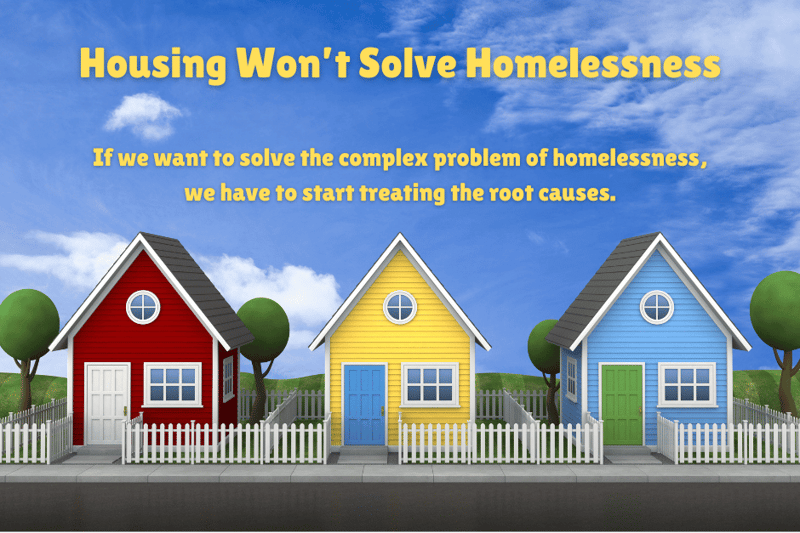Housing Won't Solve Homelessness

Have you ever noticed that we love our quick fixes? No matter what the problem is, we just want a pill, a device, or some other simple solution to fix the problem.
We spend our money on simple solutions only to discover that it cannot solve a complex problem. Sometimes the side effects of the simple solution actually make the problem worse.
Homelessness is one of those complex problems that has no simple solution.
The federal government shifted its homeless programs to the Housing First approach in 2013. The theory is that homelessness is simply a housing problem, therefore providing “affordable housing” will solve the problem.
Housing First utilizes government-subsidized housing vouchers and assistance with no preconditions or service participation requirements. “Affordable housing” has become the simple solution to try to fix the homelessness problem in multiple communities.
So, let’s evaluate how well our simple solution is working.
1. Homelessness in the United States is now 26.5% higher than it was in 2013 when Housing First started.
2. Federal funding for homeless programs has increased by 4.65 billion dollars per year, a 97.2% increase, since 2013.
3. The number of people experiencing homelessness in 2024 was the highest ever recorded.
Here is the reality…
“Affordable housing” will never solve the homelessness problem because losing your housing is just a symptom of the problem that causes homelessness.
We can clearly see from the 26.5% increase in homelessness that Housing First is not working. But the side effects of Housing First are actually making things worse.
Steve Corbett and Brian Fikkert tell us in their book, When Helping Hurts, How to Alleviate Poverty without Hurting the Poor and Yourself, that “if we treat only the symptoms or if we misdiagnose the underlying problem, we will not improve their situation, and we might actually make their lives worse.”
That was echoed by the United States Interagency Council on Homelessness in October 2020 when they said, “policies that do not address the real root causes of homelessness, combined with high housing costs in overregulated markets, have exacerbated the homelessness condition in America.”
Often, when the government provides subsidized housing, the qualified tenant pays a very reduced rental rate, while the government pays the property owner the balance of the full rental rate. They may also lease multiple properties at the market rate in the same community.
One of the unintended side effects of government subsidized housing is that it drives up the cost of rent and drives down the availability of rental properties for the entire community. “Affordable housing” is not affordable for people who do not get government assistance.
The biggest problem with Housing First is that it just treats a symptom of the problem.
Treating symptoms provides some temporary relief, but the underlying problem remains untreated and shows back up with other symptoms like addiction, crime, mental health problems, and eventually a return to homelessness.
Feeling frustrated with people who have all these symptoms, many communities are now trying to “house” the homeless in areas where they are not impacting everyone else.
Old motels, sheds, or various other encampments keep the homeless out of sight, but there is no effort made to help them build a functional life. Most of these “homeless encampments” are built and operated using government funding.
With no help to address the real problem, the homeless are destined for a life of dysfunction and government dependency.
If we want to solve the complex problem of homelessness, we have to start treating the root causes.
Multiple studies, over 15+ years, have produced consistent and well-documented evidence of high levels of repeated trauma within individuals and families who are homeless.
Repeated trauma dysregulates most of the body’s processes, damages the nervous system, and profoundly impacts the brain. “Trauma results in a fundamental reorganization of the way mind and brain manage perceptions. It changes not only how we think and what we think about, but also our very capacity to think.” (Bessel van der Kolk, M.D., The Body Keeps The Score, Brain, Mind and Body In The Healing Of Trauma).
Some of the impacts of repeated trauma are barely controllable emotions, difficulty completing routing tasks, problems learning and remembering, and poor decision making.
These studies, together with our experience, show us that people with repeated trauma are much more likely to have serious job problems, be addicted to drugs or alcohol, go to prison, have mental health problems, and become homeless.
All the things we think cause homelessness are just symptoms of the underlying trauma problem.
Treating the trauma is the only way to solve the homelessness problem. Greenwood Pathway House provides trauma-specific services that address the root causes of homelessness.
Our goal is to help our clients build a functional life, post-trauma, that equips them to overcome homelessness permanently. The only way to achieve that goal is to help them become thriving members of our local community.
Addressing the root causes of homelessness is not easy, and "cookie-cutter" solutions for trauma and homelessness are ineffective. Every person is different, every trauma is different, and every situation is different.
Because the needs are so varied, it is essential that a community provides comprehensive and integrated services. It takes multiple community partners working together to provide the help they need.
It also takes time - time to process the trauma and time to save up two months’ rent and a security deposit.
But the reward of treating the root causes is seeing people thrive and our community getting stronger.
In Greenwood County, South Carolina, our homelessness is now 44.5% lower than it was in 2013. We believe it is a direct result of a community working together to address the root causes of a problem instead of just treating the visible symptoms.
As our homeless neighbors start to thrive, they become employees, volunteers, tax payers, tenants, and even homeowners that give back to our community. We have seen first-hand that the homeless can become an economic benefit to the community.
So here is the real question: Does your community want their homelessness to be 26.5% higher - or 44.5% lower?
Homelessness is a complex problem that can be solved by treating the root causes. But it requires that we stop using tax dollars to hide the homeless while we only treat one symptom of the problem.
